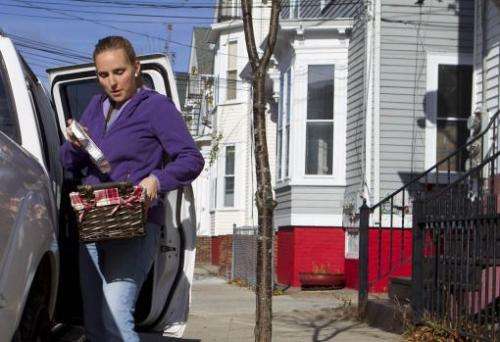Delivered meals help seniors stay in their homes

The more states spend on home-delivered meals under the Older Americans Act, the more likely they are to help people who don't need nursing home care to stay in their homes, according to a newly published Brown University statistical analysis of a decade of spending and nursing home resident data.
"Despite efforts to rebalance long-term care, there are still many nursing home residents who have the functional capacity to live in a less restrictive environment," wrote gerontology researchers Kali Thomas and Vincent Mor in the article published online Dec. 3 in the journal Health Services Research. "States that have invested in their community-based service networks, particularly home-delivered meals, have proportionally fewer of these people than do those states that have not."
Nationwide in 2009, 12.6 percent of nursing home residents were considered "low-care," meaning they did not need much of the suite of services that a nursing home provides. That proportion had declined from 17.9 percent in 2000 because of a variety of efforts, including OAA programs as well as Medicaid-sponsored home- and community-based services (HCBS).
But the percentages every year vary widely between the states. A major reason for that state-to-state variation turns out to be the difference that home-delivered meals can make. The researchers wrote that their analysis boils down to this ratio: For every $25 per year per older adult above the national average that states spend on home-delivered meals, they could reduce their percentage of low-care nursing home residents compared to the national average by 1 percentage point.
Thomas and Mor's calculations didn't merely associate each state's meals spending with its percentage of low-care residents in nursing homes. They also statistically controlled for the overall decline over time and a wide variety of factors that might also have affected the rates. Those factors included state spending on Medicaid HCBS, as well as a variety of long-term care market pressures, such as excess capacity or nursing home reimbursement rates, that could create incentives for nursing homes in different states to pursue or forgo relatively profitable low-care residents.
The data included state spending on OAA programs and performance information from each state between 2000 and 2009 as well as variety of public health and nursing home data sources compiled by Brown University's Shaping Long-Term Care in America Project. In all, 16,030 nursing homes were included in the research.
After all the analysis, home-based meals, which served more than 868,000 people in fiscal 2010, emerged as the only statistically significant factor among OAA programs that affected state-to-state differences in low-care nursing home population. Home-delivered meals account for the bulk of OAA spending.
Other factors keeping low-care residents out of nursing homes in some states included a high proportion of residents receiving skilled nursing care, which provides nursing homes with higher revenues. Factors that drove more low-care residents of some states into homes included high nursing home capacity and a high percentage of residents with not-so-lucrative Medicaid funding.
Meals mean a lot
Lead author Thomas said that as a Rhode Island Meals on Wheels volunteer and the granddaughter of a Meals on Wheels beneficiary, she was not surprised to see that the program has such a significant impact.
Until her grandmother died in October, she was able to live at home despite suffering from macular degeneration that made it impossible for her to cook.
"My 98-year-old granny was able to remain at home, independent in her house until she died, and we have always, even before I did this research, attributed that to Meals on Wheels," Thomas said. "She lived four hours away from any family and refused to leave her house. We had comfort in knowing that every day someone was in her house to see how things are."
Drivers, after all, not only bring food every day but also observe the condition of their clients. If the elderly beneficiary doesn't answer a delivery, drivers report that. The volunteers therefore provide food and a "safety check" for many older adults.
For retired journalist and state worker Bill McNamara, 90, of Warwick, R.I., Meals on Wheels helps because he and his wife Catherine, also 90, have developed arthritis in recent years that makes food preparation too difficult. Since 2009 they have lived in an in-law unit of their son's house, but because his son and daughter-in-law both work, McNamara said, asking them to prepare all their meals would be a significant burden.
Instead, Meals on Wheels of Rhode Island provides that service, McNamara said. The food is great and the drivers work hard to ensure consistent and timely delivery, he said. They even faithfully worked around the recent obstacle of the road being closed for a time.
"We feel it's even better than we would have anticipated," McNamara said. "We look forward to hearing the bell ring."
For many seniors, especially those who don't live with such a supportive family like the McNamaras, research shows that meal delivery is what allows them to remain where the ring of the doorbell is for their own door.















